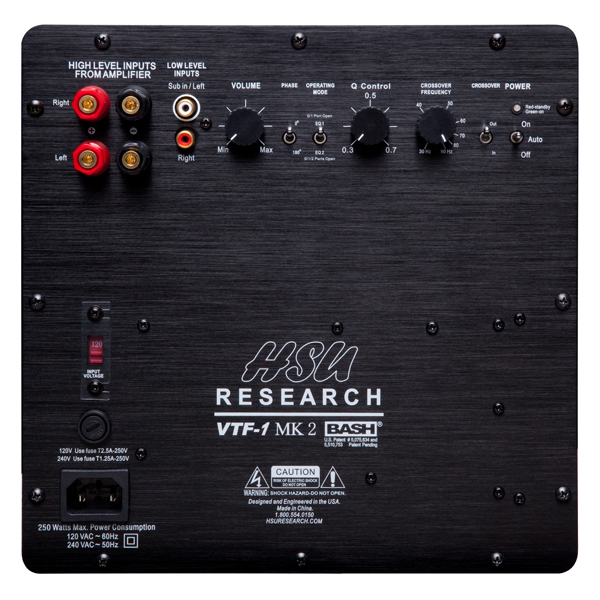The photos in the article are incorrect (again). That is not the VTF1-mk2 as described in testing, its the VTF15H-mk2
DALI Zensor 5 Speaker System and Hsu Research VTF-1 MK2 Subwoofer Reviews Page 2
Sub Star
Blending the Zensor 5s with the Hsu Research VTF-1 MK2 subwoofer was relatively easy—and it was possible to a greater degree of precision than is sometimes the case, thanks in no small part to the sub’s unusually extensive set of phase, EQ, and crossover adjustments. There are two EQ modes, a continuously variable “Q” control, and two individually pluggable ports (foam bungs are included), all of which makes for a lot of variables. Since even Hsu’s “small” sub has plenty of output for my room and tastes, I settled on its “max-extension” option, which entails plugging both ports, selecting EQ1, and crossing over the front DALI pair at 60 Hz (via my pre/pro’s setup screen). A little by-ear fine-tuning of sub level yielded a quite seamless blend of the Hsu and the Zensor 5s, as well as bass extension that, on all but the most outrageous “bass cows,” left little if anything to be desired.

So while only a supporting player here, the Hsu sub proved to be a star in its own right. It goes shockingly low and loud—equal and possibly even superior to any other 10-incher I’ve heard (except for the prodigious JL Audio E-Sub e110, which costs $1,500). On my collection of dubstep synth-bass torture tracks, it excited room rattles that I know are awakened only by substantial in-room sub-25-Hz sound pressures, and it had plenty left for dynamic events. At my preferred volume, a few decibels shy of reference level, my favorite film-sound clips produced a solid, carpet-flapping bottom octave, free of either doubling or excess, second-octave bass bloat. No question, the VTF-1 MK2 is a winner.

If this combo sounds just about ideal for movie night, you’re correct. Taken 3 is a rather limp example of the art of the sequel, although I warmly endorse its suggestion that at least some of us guys of a certain age still got it—well, one of us guys. At any rate, its soundtrack contains all the elements of the modern action genre: lots of gunfire, lots of ominous synth-bass rumblings, lots of car chases, and lots (and lots) of fist-slugs and body-slams. The DALI-Hsu cohort performed admirably on all of these. The little Zensor 1s worked quite satisfactorily in the surround locations (aimed a bit to the rear, so that they washed along the side walls, as I always position direct radiators), while the Zensor Vokal center speaker produced clear, easily intelligible dialogue from everything I threw its way.
Central Success
Notably, in my setup at least, the Vokal produced an unexpectedly close timbral match to its mini-tower flankers. When I compared stereo sound with 5.1 playback on a range of centered announcers, both male and female, the Vokal was consistently very, very close, revealing itself by only a tiny dose of higher-midrange hollowness and lower-mid bloom (both probably due as much to floor- and screen-bounce as to the speaker itself). The Vokal appears to be a perfectly ordinary, three-driver, horizontal two-way, albeit with the dual woofers spaced somewhat more closely together than in many such designs, which could well be a factor. Whatever magic (or perhaps luck) DALI employed in its design, kudos are due, especially as this close match engendered a more than usually solid, unified front-stage image, one that served Taken 3’s many frenetic, laterally panning chase effects quite well.
Whether in stereo or multichannel playback, the DALI speakers proved capable of ample clean output, absorbing most of my power amp’s 150 watts per channel before showing any audible strain. At the same time, since all three Zensor models are of only average sensitivity, something on the order of 100 watts per channel is by no means excessive. That said, these are relatively small two-ways, so a listener with both an unusually large room and a taste for rock-concert levels may find the speakers falling a bit short in output capability.
At Home Among the Crowd
In the end, I can find nothing much critical to say about DALI’s Zensors: They are a finely balanced, well-engineered suite. Nevertheless, they’ve got a lot of competition: Just about all respectable loudspeaker makers (and plenty of less respectable ones) offer a range of value-priced, China-manufactured two-ways, and many of these are awfully good as well, and sold at highly competitive prices. Such a wealth of choices surely makes shopping both challenging and rewarding, in a crowded field where DALI’s Zensors will prove to be very much at home.
- Log in or register to post comments
































































